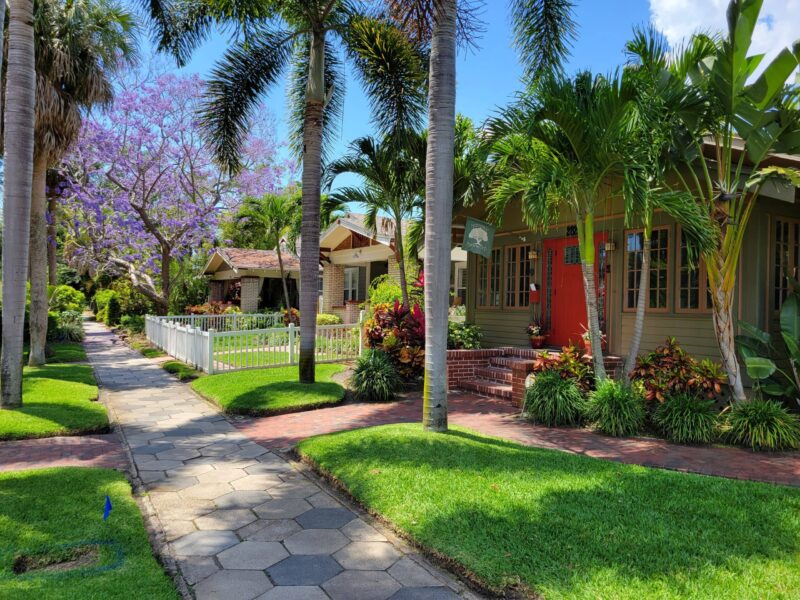Place
Home values soar in St. Pete’s historic districts

Manny Leto realizes that touting historic preservation’s benefits is often a subjective debate centered around aesthetic appeal; he now has data highlighting its economic impacts.
Leto, executive director of Preserve the ‘Burg, commissioned Place Economics to study property values throughout St. Petersburg. The Washington, D.C.-based consultancy firm found that home prices in local historic districts increased by 119.3% over 14 years, compared to 85.2% in other areas.
The study also found notable correlations between historic preservation, neighborhood density and job creation. Leto said the two-year initiative allowed his organization, which typically reacts to impending demolitions, to take a proactive approach.
“We should be thinking about historic properties and historic neighborhoods as assets, as resources,” Leto said. “And I think putting numbers to that helps people understand that a little bit more clearly.”
Place Economics has studied nationwide preservation trends for over three decades. Its local report debunked a common misperception that local historic district designations negatively impact long-term property values.
The national firm studied St. Petersburg property appraisals from the real estate crash in 2008 through 2022. Leto said the average square foot value of homes in historic districts outpacing those in other areas by nearly 35% shows that historic preservation supports more than aesthetically pleasing neighborhoods.
“It’s more than just a conversation about front porches,” he added. “It’s a conversation about what role these structures play in the economics of a community.”
Those opposed to preservation efforts often accuse stakeholders of slowing growth by attempting to save buildings throughout the city. Leto said that about .05% of St. Petersburg’s structures exist in a local historic district.
He also agrees that the city, where possible, must increase density. However, the study also found that local historic districts are slightly denser than other neighborhoods.
Place Economics found that historic districts are home to 7.8 people per acre, compared to 7.2 in similarly zoned areas throughout St. Petersburg. “You are not solving the density issue by demolishing historic buildings,” Leto said.
He said those homes also offer “some measure of affordability.” While rents likely surpass those in income-restricted subsidized developments, Leto said, “You’re never going to be able to build new and rent cheap.”
The study found Central Avenue, from 31st Street east to Beach Drive, is home to about 275 buildings. Roughly 60% were built before 1960, and most opened in the 1920s and 1950s.

George Sayegh, owner of Bodega, believes his building’s unique facade helps attract foot traffic.
Place Economics also surveyed 391 residents, and 44% of respondents said they visit the commercial corridor to shop, dine or conduct business at least once a week. Another 36% said they frequent the area once or twice a month.
In addition, the study found that jobs increased by over 50% on Central Avenue between 2010 and 2020, compared to about 17% throughout St. Petersburg. “Good cities have what we call layers of history,” Leto said.
“Just think about the places you want to go on vacation,” he continued. “I guarantee it’s not the suburbs of your favorite city – it’s to the historic areas of these places.”
Leto said smaller and older buildings are also more affordable for small business owners. He believes those structures are also easily adaptable to new uses.
George Sayegh, owner of Bodega, mostly agreed. His restaurant amassed a loyal following from a minuscule, unique early 20th-century building on Central Avenue.
Sayegh then found a larger historic building about a block away to continue growing his business. He called the distinctive architecture a marketing point that attracts foot traffic.
“Everyone loves Bodega, and it does great business,” Sayegh explained. “But if you put in a parking lot next to the busiest Publix in Florida, it’s not going to be as busy as it is in that quirky little building. Especially the little one that we started in. I think that has a lot to do with the building itself.”
He said Central features a “pretty good mix” of old and new structures. Sayegh also believes continued growth is inevitable and doesn’t begrudge owners who can now sell once undesirable space to developers.
Sayegh added that the cost to remodel and maintain historic structures is sometimes untenable. However, he would also “hate to see any more of those nice buildings disappear. Otherwise, there’s not going to be too much character left on that street.”
Preserve the ‘Burg will officially unveil the report Friday, May 10 at its annual Preservation Expo. The free event, held from 10 a.m. until 3 p.m. at the St. Petersburg Museum of History, will feature several local, state and national presenters and over two dozen exhibitors.
For more information, visit the website here.








Lois
May 9, 2024at1:00 pm
St. Petersburg used to be a wonderful place to live .Greed certainly has taken over. Such a shame
certainly glad I no longer reside there.
Will Michaels
May 8, 2024at5:30 pm
Affordability is a priority and gentrification is a concern that needs to be addressed. As PlaceEconomics notes older housing stock plays a critical role in providing naturally-occurring affordable housing. (38% of housing in the city was built before 1960.) Housing that does not have historic designation is at risk for demolition and development, and replacement housing will be more costly. Also historic-designated housing is often eligible for grants to assist with maintenance. For example in the downtown there is a 5M fund most of it unused to assist owners of historic properties. A needed plan for advancing historic preservation should include the goal of maintaining remaining affordable housing.
Ryan Todd
May 8, 2024at4:37 pm
Historic Preservation makes once affordable neighborhoods unattainable for those they were intended for. Kenwood and Uptown, for example, are compromised of small bungalows once affordable for first-time home buyers. Yuppy preservationists have driven prices sky-high in Kenwood.
Preservation is an important tool, but must be used sparingly or else it’s merely a gentrification accelerant.
Sandra Day
May 8, 2024at7:33 am
It has gotten to expensive for ordinary folks to live here any more. Rent is way to high we need to get a grip
Will Michaels
May 7, 2024at8:00 pm
While St. Petersburg has many plans it has no pro-active plan for advancing historic preservation. Perhaps the PlaceEconomics Report together with a proposal pending before the Community Planning & Preservation Commission could serve as the basis of such a needed plan. Also, the City should consider establishing a citizens task force for assisting in accomplishing this. “If you don’t know where you are going you probably will not get there.”